Reserve Bank of Australia Annual Report – 1987 Economic Developments[+]
The international economy
The industrial economies continued to grow moderately in 1986/87, but large and growing external imbalances increasingly dominated international developments. There was slow progress in policy co-ordination between OECD countries and heightened protectionist pressures, especially in the United States.
Assisted by falls in oil prices, rates of inflation declined in many countries in the first half of 1986/87. Commodity prices remained weak overall, particularly for wheat, iron ore and coal. Some commodities of importance to Australian trade, notably gold, wool and meat, benefited from more buoyant markets.
External imbalances and exchange rates
External imbalances remained a major problem for economic policy. In the year to June 1987, the United States' current account deficit was estimated at US$149 billion (3½ per cent of GNP), compared with US$129 billion (3 per cent of GNP) in the year to June 1986. Current account surpluses in Japan and West Germany grew. In part, the widening imbalances over the course of 1986/87 reflected the effects of changing exchange rates on domestic currency prices of imports and exports; adjustments in trade volumes were insufficient to offset these effects.
As in 1985/86, the persistent trade imbalances were reflected in exchange rate movements among the major currencies. Over the year to June 1987, the U.S. dollar depreciated by over 10 per cent on a trade-weighted basis, compared with a fall of more than 23 per cent over the course of 1985/86.
Economic policies
Proposals for the co-ordination of economic policies among industrial countries remained the focus of discussion at several meetings during 1986/87. Member countries of G-7 met in Washington in September 1986 as part of the multilateral surveillance exercise agreed at the Twelfth Economic Summit meeting held in May 1986. Discussions between Finance Ministers of the United States and Japan took place in October.
A meeting of monetary officials from the G-5 countries plus Canada was held in Paris in February 1987. In the resultant Louvre Accord the group agreed that exchange rate movements since the Plaza Agreement of September 1985 had brought currency values within ranges “broadly consistent with underlying economic fundamentals”. Agreement was also reached on the need to intensify efforts to co-ordinate the economic policies of the major economies. In broad terms, countries with current account surpluses committed themselves to expand domestic demand to help reduce surpluses, while countries with current account deficits undertook to encourage steady, low-inflation growth and, at the same time, take steps to reduce their domestic imbalances and their external deficits. To date, there has been only limited progress in the fulfilment of these commitments.
In June 1987, Heads of Government of the seven major industrial countries and representatives of the European Economic Community met in Venice for the Thirteenth Economic Summit, and reaffirmed their commitment to reducing external imbalances. It was agreed that exchange rates were broadly in line with economic fundamentals and that more progress needed to be made in altering the balance of domestic policies; the costs of high levels of farm subsidies were recognised.
The objective of greater policy co-ordination influenced the setting of economic policies at the national level. In particular, the divergence of fiscal policies among major countries was somewhat reduced. In the United States, the Administration's proposed budget for fiscal year 1988 aimed to meet the targets set by the Gramm-Rudman-Hollings Balanced Budget Act, though parts of that legislation have been ruled unconstitutional. The House and the Senate have proposed plans that would produce somewhat larger deficits. All of these proposals would constitute a tightening in fiscal policy. In Japan, a series of supplementary budgets aimed to boost domestic demand with increased spending on public works and measures to boost private sector activity. Tax reforms have been implemented in the United States and are under consideration in other countries.
13 INTERNATIONAL ECONOMIC CONDITIONS
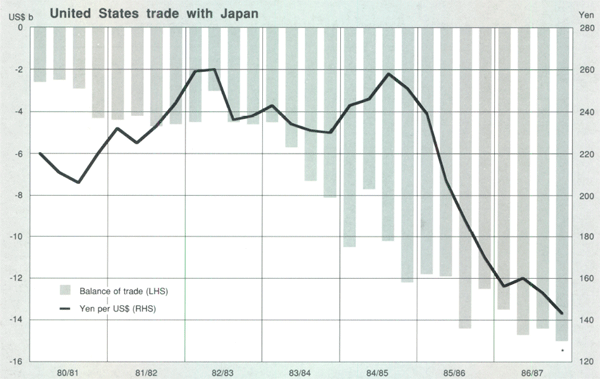
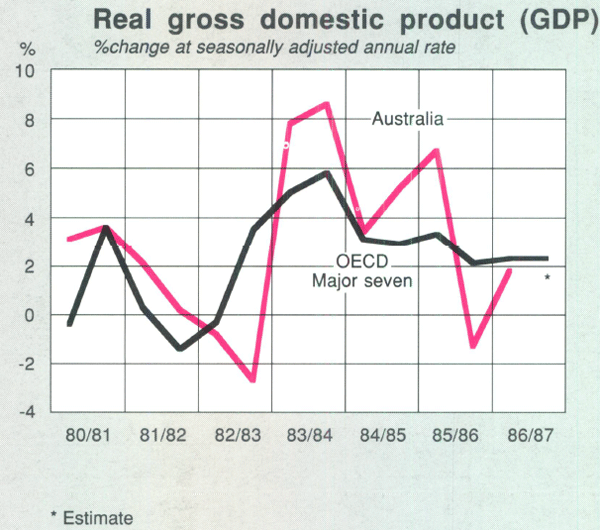
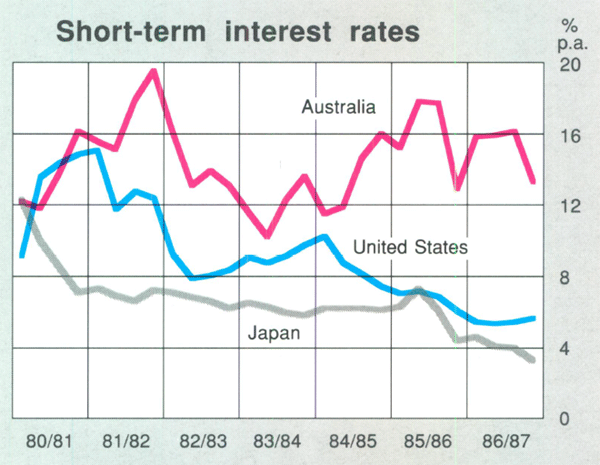
These adjustments have not proceeded quickly enough to prevent increasing attention to trading policies. In August 1986, amendments to the United States' Banking Act expanded the scope of the Export Enhancement Program. The sale of subsidised rural exports, particularly grains, saw the United States encroach on a number of Australia's traditional export markets. Trading issues resulted in strained relations between the European Community and the United States. Disagreements over access to particular markets have heightened tension between Japan and the United States, raising the prospect of extensive protectionist measures and a marked slowing in world trade.
Multilateral trade negotiations under the General Agreement on Tariffs and Trade (GATT) commenced during 1987; discussions will include consideration of agricultural trade and services for the first time.
Major countries used monetary policy more flexibly during the year. Growth in some monetary aggregates exceeded their target ranges in the United States, West Germany and the United Kingdom in 1986, though interpreting these developments remained difficult because of changing financial relationships and large international flows of capital. Official interest rates were lowered during the year in many countries.
These reductions often reflected pressures in foreign exchange markets. Most market interest rates fell significantly in 1986/87, reflecting accommodating monetary conditions and lower inflation rates. In the United Kingdom, however, interest rates rose in the first half of 1986/87 before falling in the second half of the year and in the United States they began to rise towards the end of 1986/87.
Debt of developing countries
Moderate economic growth in major industrial countries and substantially lower interest rates aided debtor countries during 1986/87. However, many continued to experience low export prices for commodities. Toward year's end, there was upward pressure on the interest rates on their external borrowings and prospects for growth in the industrial countries worsened. Lower oil prices assisted oil-importing countries but added substantially to the difficulties of heavily-indebted oil exporters.
The “Baker Plan” to help ease the problems of international debt, proposed at the annual meeting of the International Monetary Fund in October 1985, was put into practice in the second half of 1986. Mexico was the first country to renegotiate its external debt payments under the plan. In February 1987, however, Brazil unilaterally suspended interest payments on its debt to foreign banks for an indefinite period. A number of international banks announced that they had made substantial additional provisions against loans to heavily-indebted developing countries which had entered into debt rescheduling arrangements. Some lenders have participated in debt-equity swaps to reduce the burden of poorly-performing loans to indebted countries.
International capital markets
Funds raised through bond issues on international markets expanded further in 1986/87, in effect substituting for syndicated loans and other bank lending. The value of new bond issues was 12 per cent higher than in 1985/86. Raisings in New York fell by US$3 billion to US$95 billion and accounted for only 52 per cent of all raisings, compared with 62 per cent in 1985/86. Raisings in the Eurobond markets grew to a record US$182 billion, with strong growth in fixed-rate issues.
The Australian dollar sector of the Euromarket grew to $A10.3 billion in 1986/87, from $A6.8 billion in the previous year. It now represents around 5 per cent of total issues in the Euromarket.
Economic conditions in Australia
1986/87 was characterised by slow economic growth, relatively high inflation and a large current account deficit. There were signs, however, that the process of adjustment to changed economic circumstances was beginning.
After contracting in the second half of 1985/86, the Australian economy grew only slowly in 1986/87. Private domestic demand fell but, reflecting the improvement in Australia's competitive position, the external sector made a substantial contribution to growth.
The rate of inflation remained high, exceeding that of most of Australia's trading partners by an increased margin. Continuing inflationary effects of earlier falls in the Australian dollar were important. Award wage decisions remained moderate, but “wages drift” continued. Real wages, nevertheless, fell further during the year.
Despite the slowdown in economic activity, the labour market showed considerable resilience. This was due in large part to the continuing effects of restraint in real wages over the past several years.
A further fall in the terms of trade largely offset the improvement in net export volumes, with the result that the current account deficit remained high in dollar terms but fell by around one per cent of gross domestic product. The level of Australia's external debt rose further and the servicing burden increased significantly in relation to both exports and gross domestic product.
Production and spending
Real gross domestic product rose by an estimated 1½ per cent in 1986/87. As was expected at the start of the year, the major stimulus to growth in 1986/87 came from the external sector, which appears to have contributed around 2½ percentage points to growth in output.
Domestic demand was weak in 1986/87. Checked by a fall in real earnings, growth in private consumption expenditure was the lowest since the 1950s. Business investment was subdued and non-farm stocks were run down. Against this, growth in public demand, while less than in previous years, contributed to growth in GDP.
Labour market
Despite the weakness in economic activity, employment grew reasonably strongly in 1986/87, though more slowly than in the previous two years. Employment increased by 2 per cent over the course of the year. The labour force grew a little more strongly than this. The rate of unemployment rose sharply early in the financial year to 8.3 per cent and remained at about that rate for most of the year; in June 1987 the unemployment rate was 8.0 per cent compared with 7.6 per cent a year earlier.
Prices and wages
Australia's rate of inflation rose in 1986/87 and remained substantially above rates recorded by its major trading partners. Annual growth in the consumer price index reached 9.8 per cent in the year to the December quarter 1986. The Statistician estimated that increases in the prices of wholly or predominantly imported goods (excluding petrol) added more than one percentage point to growth in the consumer price index during the year. After allowing for indirect and flow-on effects, the total inflationary effect of depreciation was undoubtedly larger.
14 TERMS OF TRADE AND CURRENT ACCOUNT
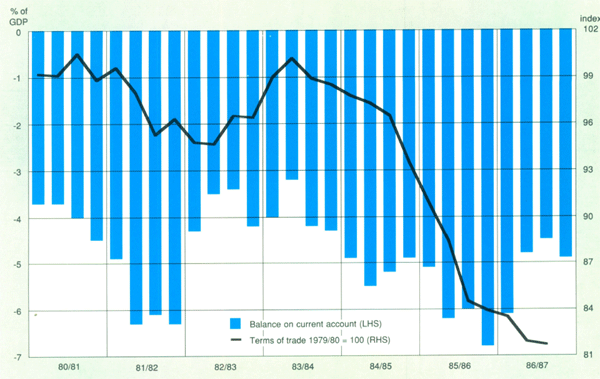
Changes in wage-fixing arrangements in 1986/87 were aimed at introducing a greater degree of flexibility into the wage-setting process, while restraining overall growth in wages. The system of wage indexation which had been in place since late in 1983 was abandoned in December 1986. In March 1987, the Arbitration Commission awarded a “first-tier” wage increase of $10 per week to all wage and salary earners (equivalent to 2.3 per cent of ordinary-time earnings), and placed a ceiling of 4 per cent on wage rises under the “second tier”. Negotiations over second-tier rises are widespread at both the industry and enterprise level. To date, most agreements have involved improvements in productivity and work practices. The Commission also agreed to consider claims for improved employer-funded contributions to superannuation. A conference will be held in October 1987 to consider the possibility of an additional award wage increase of not more than 1.5 per cent for all wage and salary earners.
15 PRODUCTION, INCOMES AND EMPLOYMENT
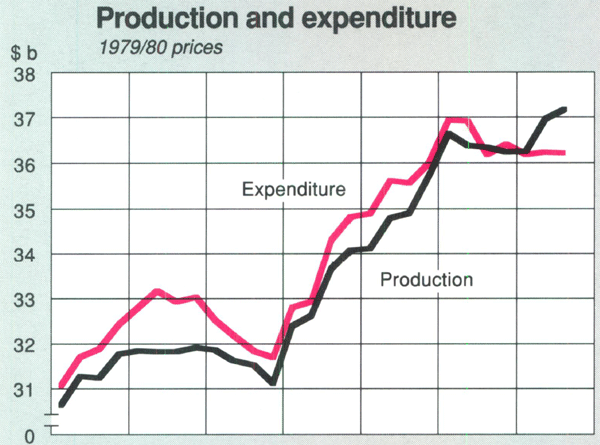
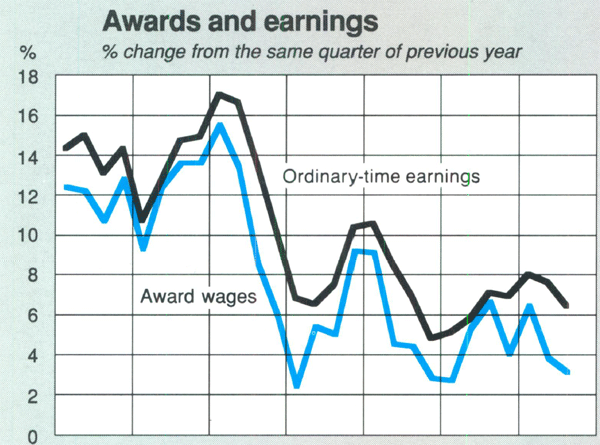
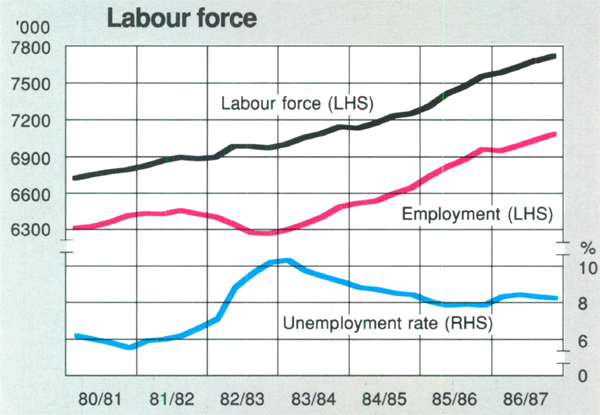
Over the twelve months to the March quarter 1987, average weekly earnings rose by 4.8 per cent and ordinary-time earnings by 6.3 per cent, substantially exceeding the increase in award wages over the same period. Growth in wages was still below that of prices; real earnings fell.
Housing
The Commonwealth Government's Housing Assistance Package, introduced in April 1986, expired at the end of March 1987.
The Package had provided a partial subsidy to assist savings banks to maintain the 13.5 per cent interest-rate ceiling on housing loans advanced before April 1986. The savings banks undertook to provide new housing loans of at least $6 billion in 1986/87. In the event, there was a large expansion in lending for housing, with new lending by savings banks totalling around $9 billion during 1986/87.
Much of the new lending was for the purchase of existing dwellings rather than for the construction of new dwellings; building activity lagged behind growth in housing finance. Private sector commencements totalled around 105,000 in 1986/87, a fall of about 15 per cent from 1985/86.
The rural sector
Conditions in the rural sector were mixed in 1986/87. The value of wheat and other grains produced fell, largely reflecting weak prices in world markets, while the value of beef and wool production rose strongly. Overall, real gross farm product rose by about 6 per cent. There was continued adjustment out of crops and into livestock. However, the longer-term outlook could be affected by depressed grain markets, reduced plantings and the threat of surpluses of meat and wool.
16 HOUSING FINANCE AND ACTIVITY
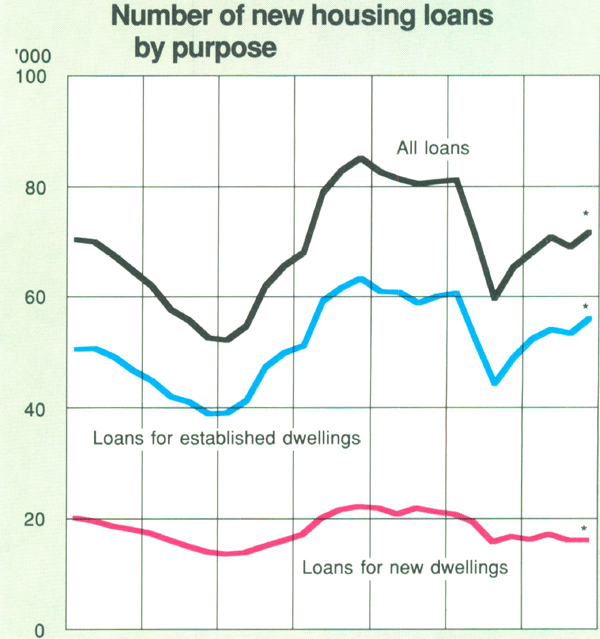
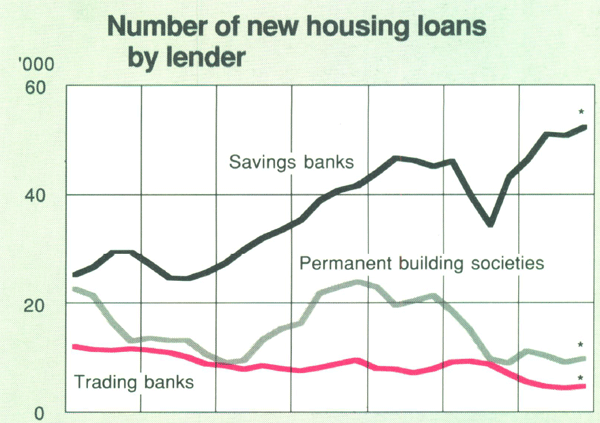
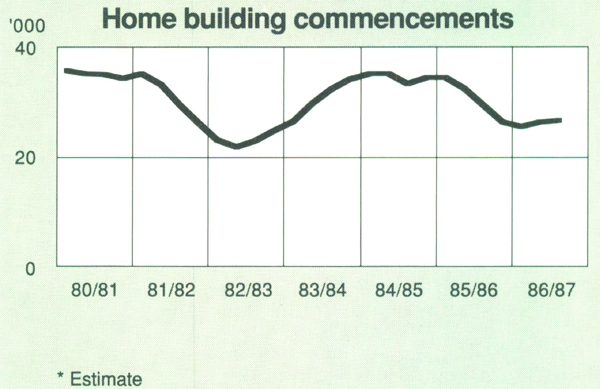
17 BALANCE OF PAYMENTS
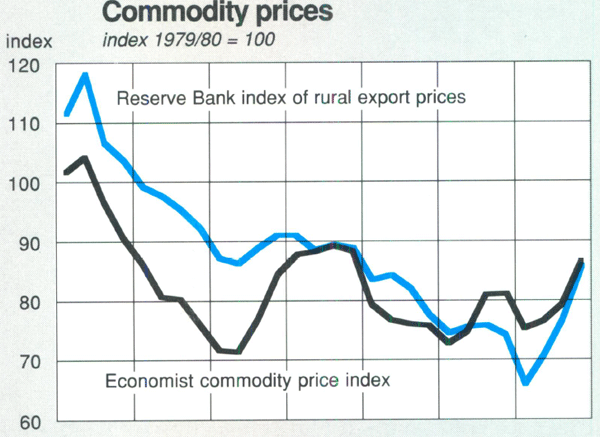
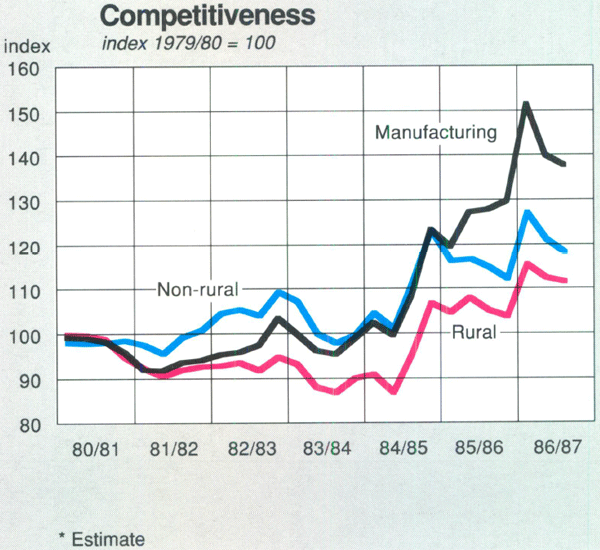
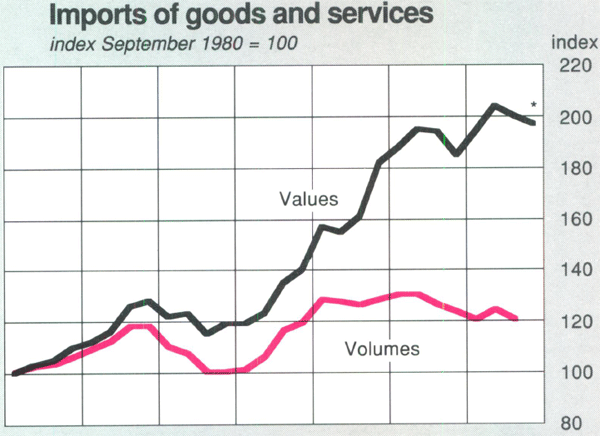
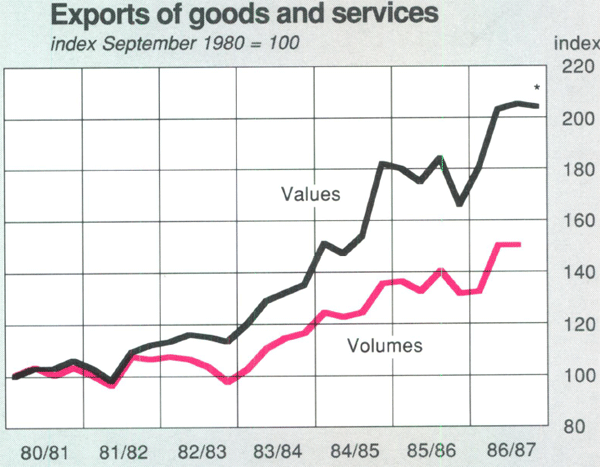
Balance of payments and external debt
Australia's severe balance of payments difficulties continued in 1986/87. The deficit on current account in 1986/87 was $13.4 billion, about 5 per cent of GDP.
The value of the merchandise trade deficit fell by over one-third in 1986/87. Very favourable movements in trade volumes were partly offset by further deterioration in Australia's terms of trade, which fell by around 5 per cent in 1986/87. Net outflows of property income, mainly associated with the rapid increase in servicing payments on Australia's external debt, again rose sharply. There was, however, a substantial improvement in the net services deficit.
The volume of exports of goods rose by about 8 per cent in 1986/87, slightly higher than the increase of 6.4 per cent in 1985/86. Non-rural exports grew strongly with large increases in exports of gold, base metals, second-hand aircraft and manufactured goods. However, iron ore and coking coal faced particularly difficult trading conditions. Rural exports rose moderately, with very large increases in exports of wool and beef partially offset by falling exports of wheat.
The $A value of export receipts was boosted by depreciation of the Australian dollar early in the financial year, but the rise was subsequently offset by the strengthening of the $A and, importantly, by deteriorating prices on world markets for some of Australia's major exports. Export prices were only about 2 per cent higher than in 1985/86.
The volume of imports fell by about 5 per cent in 1986/87. Imports fell early in the year, continuing the decline evident from the beginning of 1986. Sluggish domestic activity was a key factor, but the much improved competitive position of import-competing industries also played a part. Largely reflecting movements in the value of the Australian dollar, import prices rose by around 10 per cent in 1986/87.
Australia's trade in services has begun to respond very positively to improved international competitiveness. The net services deficit contracted substantially in 1986/87. Some of the largest gains have been in tourism.
The deficit on property income increased substantially in 1986/87, reflecting escalating interest payments on Australia's external debt. Net interest payments totalled around $8 billion, about 18½ per cent of income from exports of goods and services, compared with $6.1 billion, or 16.1 per cent of exports, in 1985/86.
Australia's external debt continued to grow in 1986/87. As in the past few years, the greater part of capital inflow was in the form of borrowings. Net overseas borrowings by governments accounted for $2.9 billion, compared with $3.3 billion in 1985/86; those by Commonwealth and State instrumentalities were $2.2 billion in 1986/87, little changed from the previous year. Net private sector borrowings totalled about $9 billion, compared with $9.1 billion in 1985/86.
Australia's gross external debt is estimated to have increased by $21 billion in 1986/87, to total $113 billion (43 per cent of GDP) in June 1987. After allowing for Australia's overseas reserves and Australian lending abroad, net external debt was estimated to be about $86 billion (33 per cent of GDP) in June 1987, compared with $73 billion (31 per cent of GDP) in June 1986.
Australia's international reserves totalled $17.6 billion at end June 1987, compared with $13.0 billion at the close of 1985/86. In SDR terms, reserves rose by SDR2.4 billion over the year, to SDR9.9 billion at end June.
Footnote
Figures in this chapter include estimates based on data available at the time of writing. [+]